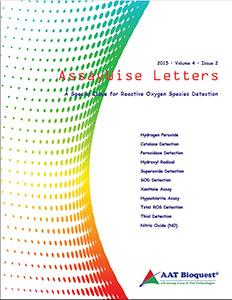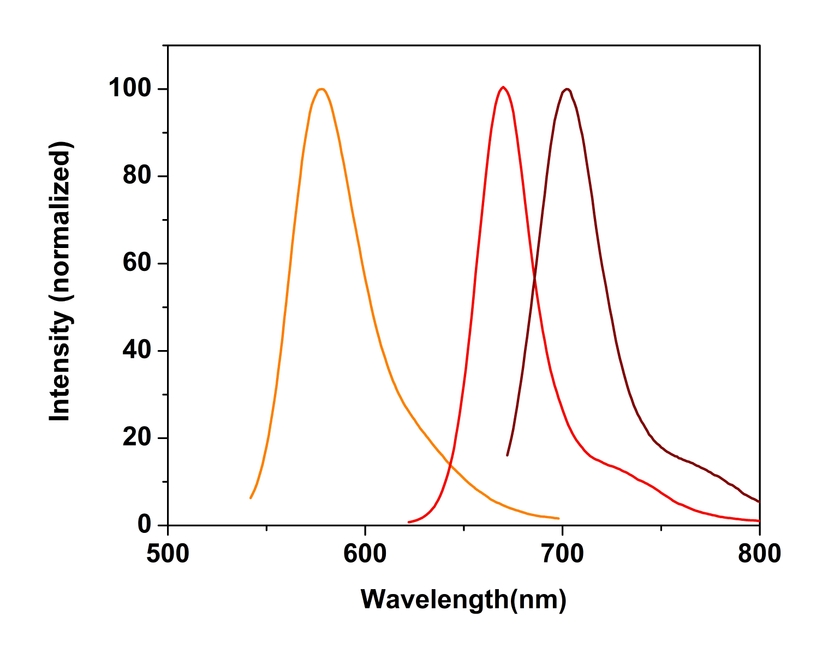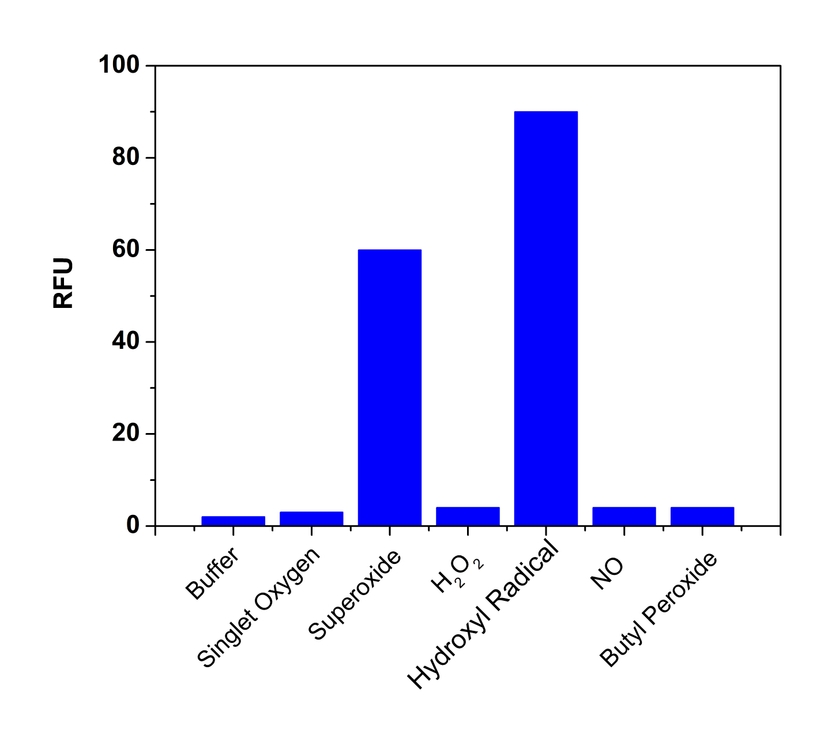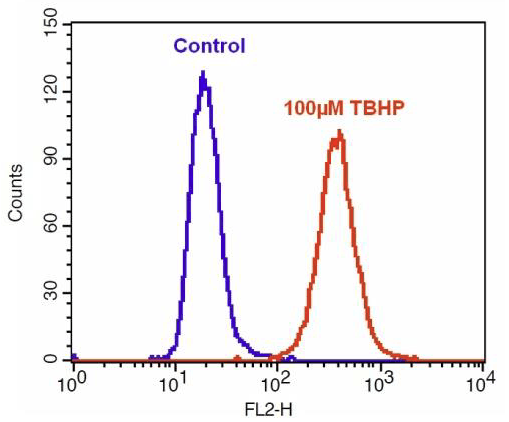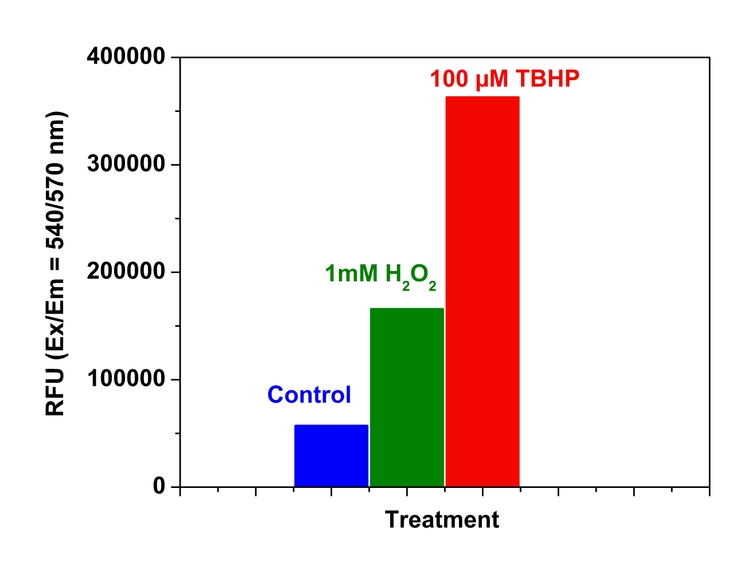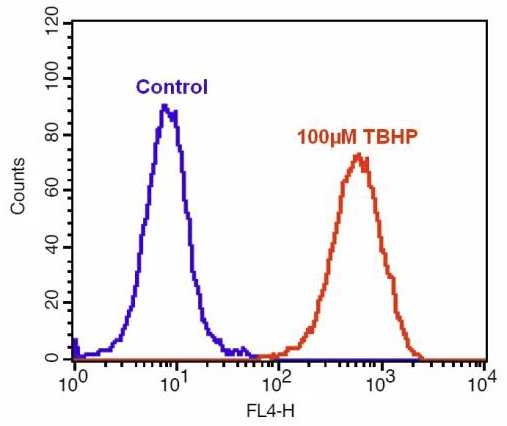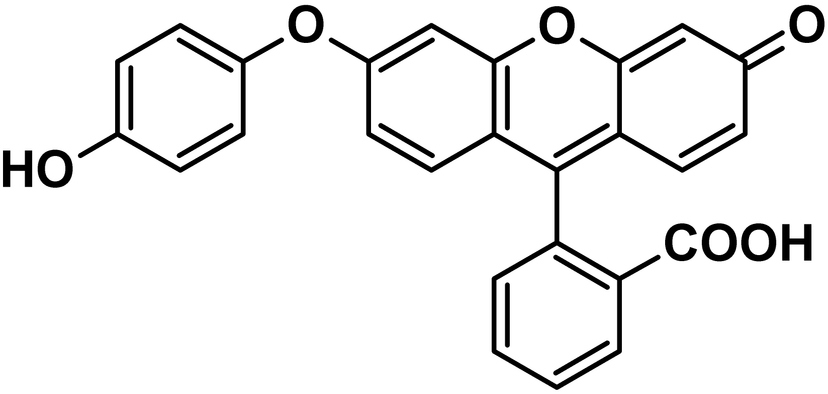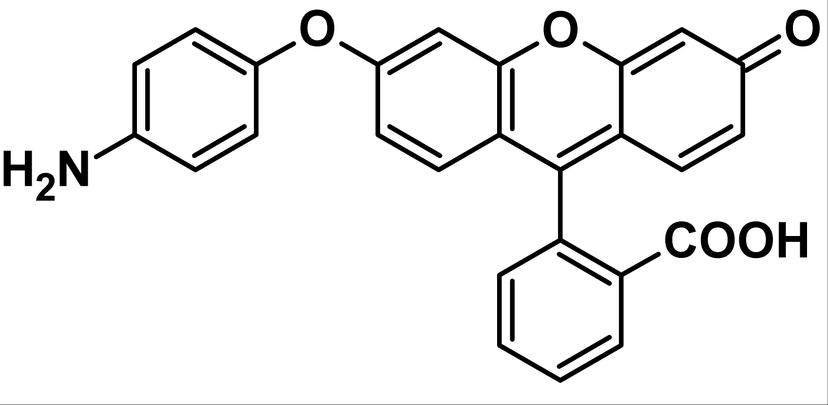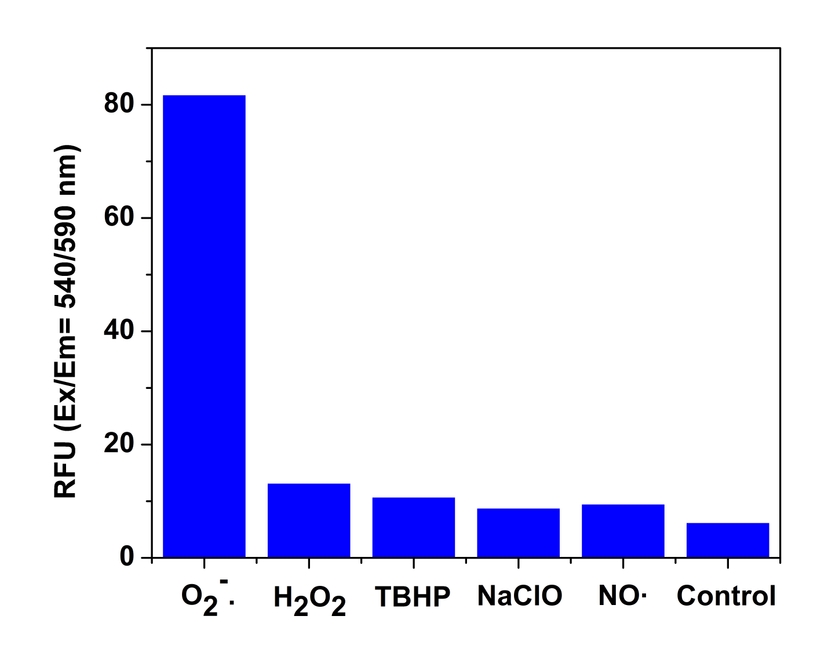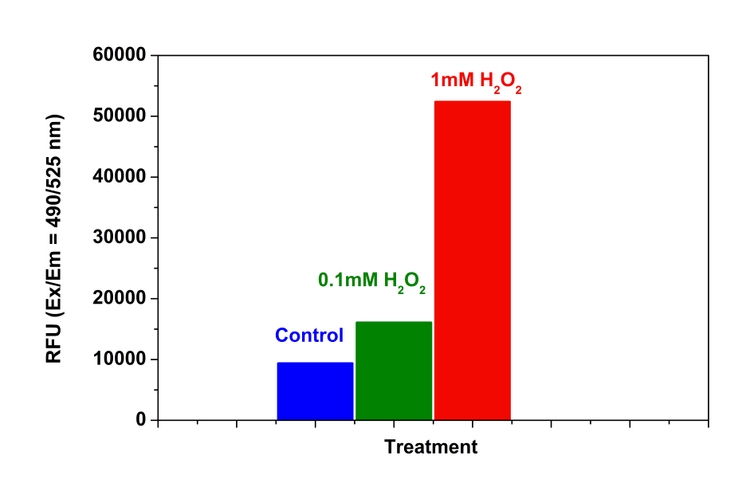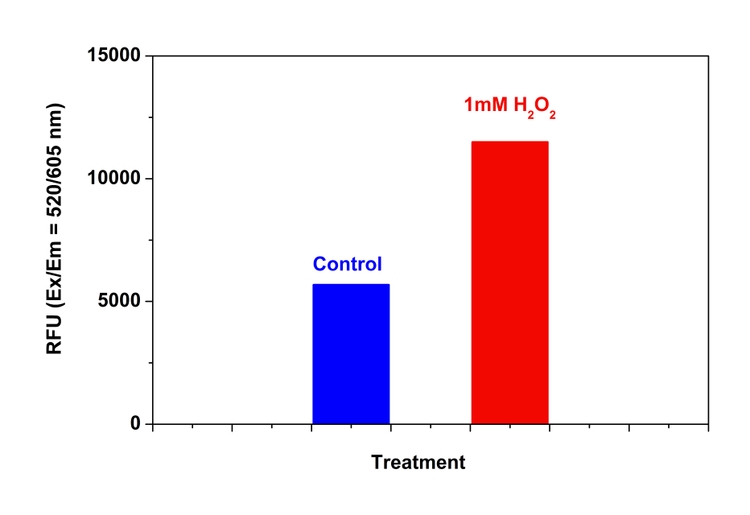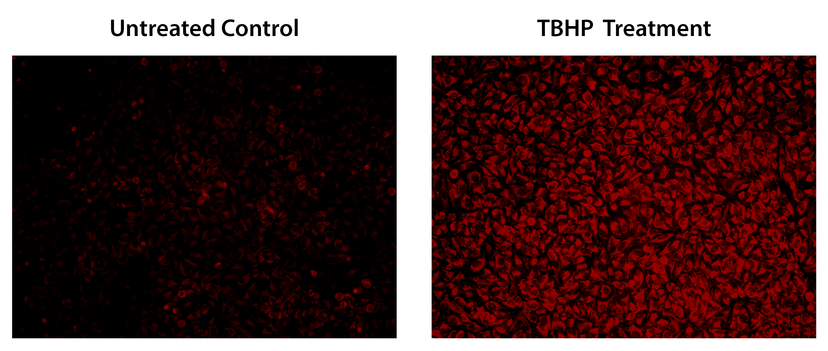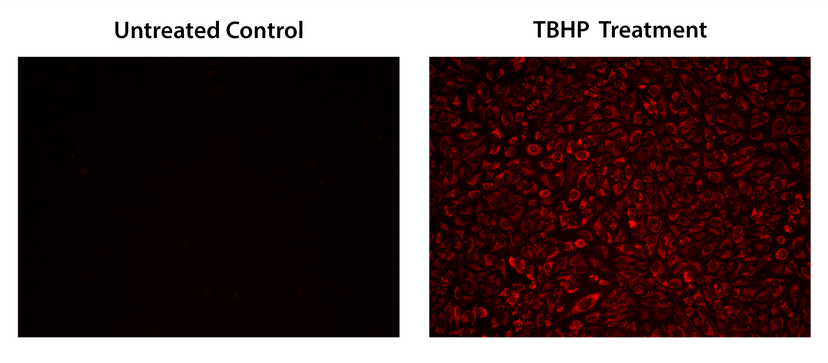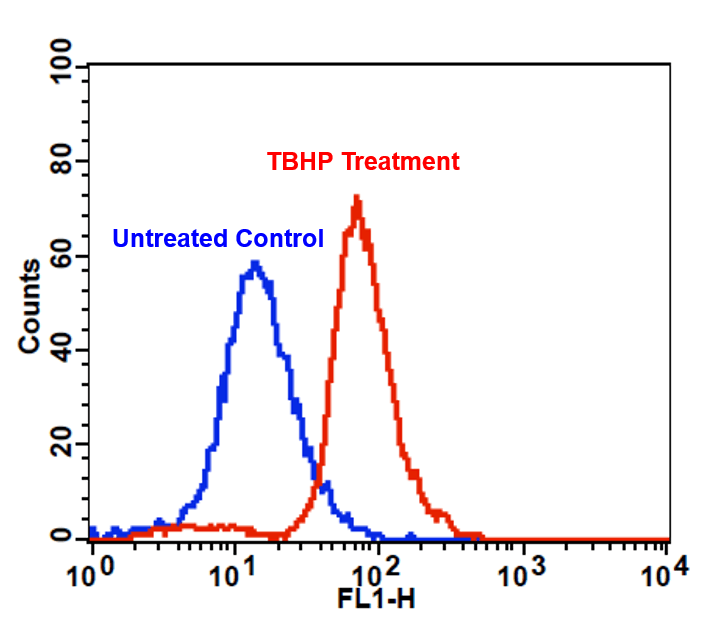Total ROS Detection
ROS Brite™ reagents are a series of new fluorogenic probes to measure oxidative stress in cells. The cell-permeant ROS Brite™ reagents are nonfluorescent and produce bright fluorescence upon ROS oxidation. The resulting fluorescence can be measured using fluorescence imaging, high-content imaging, microplate fluorometry, or flow cytometry. ROS Brite™ 570, 670 and 700 reagents have good selectivity to both hydroxyl radical and superoxide.
ROS Brite™ 570 (Cat# 16000) is a new fluorogenic probe to measure oxidative stress in cells using conventional fluorescence microscopy, high-content imaging, microplate fluorometry, or flow cytometry. The cell-permeant ROS Brite™ 570 reagent is nonfluorescent and produces bright orange fluorescence upon ROS oxidation.
ROS Brite™ 670 (Cat# 16002) can be well excited with He-Ne laser at 633 nm, making this reagent well suited for the ROS detection using a flow cytometer. Its fluorescence signal can be well monitored using the Cy5® filter set.
ROS Brite™ 700 (Cat# 16004) is a new fluorogenic probe to measure oxidative stress in small animals. The cell-impermeant ROS Brite™ 700 reagent is water-soluble. It is nonfluorescent and produces bright NIR fluorescence upon ROS oxidation. The resulting fluorescence can be measured by in vivo fluorescence imaging.
ROS Brite™ DHCF (Cat# 16053) has similar redox properties to those of 2',7'-dichlorodihydrofluorescein diacetate with significantly red-shifted spectra. ROS Brite™ DHCF is hydrolyzed by cellular esterases to generate the non-fluorescent reduced form that is then oxidized to generate the highly fluorescent free dye primarily by H2O2. ROS Brite™ DHCF might be reactive toward a broad range of oxidizing reactions that may be increased during intracellular oxidant stress. This probe can be conveniently used to monitor cellular redox processes for multiplexing assays with FITC-labeled antibodies or GFP cell lines. The oxidized product is highly fluorescent in cells. ROS Brite™ DHCF provides a valuable tool for investigating oxidative stress in various pathologies.
ROS Brite™ APF (Cat# 16050) and ROS Brite™ HPF (Cat# 16051) are fluorogenic probes to measure hydroxyly radical in cells using conventional fluorescence microscopy, high-content imaging, microplate fluorometry, or flow cytometry. The cell-permeant ROS Brite™ APF and HPF reagents are nonfluorescent and produce bright green fluorescence upon reaction with hydroxyl radical. The resulting fluorescence can be measured using fluorescence imaging, high-content imaging, microplate fluorometry, or flow cytometry. In the presence of peroxidase, APF also reacts with hydrogen peroxide. APF has good selectivity to hydroxyl radical compared to other ROS. APF and HPF show relatively high resistance to light-induced oxidation. APF will also react with the hypochlorite anion.
MitoROS™ 580 (Cat# 16052) is a superoxide-sensitive dye that is localized in mitochondria upon loading into live cells. Oxidation of MitoROS™ 580 by superoxide generates red fluorescence. MitoROS™ 580 can be used for monitoring superoxide in mitochondria either with a fluorescence microscope or a fluorescence flow cytometer. MitoROS™ 580 reagent permeates live cells where it selectively targets mitochondria. It is rapidly oxidized by superoxide. It is less likely to be oxidized by other reactive oxygen species (ROS) and reactive nitrogen species (RNS). The oxidized product is highly fluorescent in cells. MitoROS™ 580 provides a valuable tool for investigating oxidative stress in various pathologies.
Cell Meter™ Fluorimetric Intracellular Total ROS Activity Assay Kits provide a sensitive, one-step fluorimetric assay to detect intracellular ROS in live cells. The assay can be performed in a convenient 96-well or 384-well microtiter-plate format and easily adapted to automation without a separation step. Its signal can be easily read using either a fluorescence microplate reader or a fluorescence microscope. Cell Meter™ Fluorimetric Intracellular Total ROS Activity Assay Kits (Cat# 22900, 22901, 22902 & 22903) are in an optimized "mix and read" assay format that is compatible with HTS liquid handling instruments. Kit 22904 is optimized for flow cytometry applications, its signal can be detected at Ex/Em = 490/520 nm (FL1 channel).
The fluorescence spectra of ROS Brite™ 570 (Yellow, Cat# 16000), ROS Brite™ 670 (Orange, Cat# 16002) and ROS Brite™ 700 (Red, Cat# 16004).
ROS Brite™ 670 (Cat# 16002) can be well excited with He-Ne laser at 633 nm, making this reagent well suited for the ROS detection using a flow cytometer. Its fluorescence signal can be well monitored using the Cy5® filter set.
ROS Brite™ 700 (Cat# 16004) is a new fluorogenic probe to measure oxidative stress in small animals. The cell-impermeant ROS Brite™ 700 reagent is water-soluble. It is nonfluorescent and produces bright NIR fluorescence upon ROS oxidation. The resulting fluorescence can be measured by in vivo fluorescence imaging.
Left: Detection of ROS in Jurkat cells. Jurkat cells were treated without (Blue) or with 100 µM tert-butyl hydroperoxide (TBHP) (Red) for 30 minutes at 37 °C, and then loaded with ROS Brite™ 570 (Cat# 16000) in a 5% CO2, 37 °C incubator for 1 hour. The fluorescence intensities were measured with a FACSCalibur™ flow cytometer using FL2 channel. Center: Detection of ROS in HeLa cells. The cells were untreated (control) or treated with 1 mM H2O2 or 100 µM tert-butyl hydroperoxide (TBHP) for 30 minutes at 37 °C. ROS Brite™ 570 (Cat# 16000) (100 µL/well) was added and incubated in a 5% CO2, 37 °C incubator for 1 hour. The fluorescence signals were monitored at Ex/Em = 540/570 nm (cut off at 550 nm) with bottom read mode. Right: Detection of ROS in Jurkat cells. Jurkat cells were untreated (Blue) or treated with 100 µM tert-butyl hydroperoxide (TBHP) (Red) for 30 minutes at 37 °C, and loaded with ROS Brite™ 670 (Cat# 16002) for 1 hour. The fluorescence intensities were measured with a FACSCalibur™ flow cytometer using FL4 channel.
ROS Brite™ DHCF (Cat# 16053) has similar redox properties to those of 2',7'-dichlorodihydrofluorescein diacetate with significantly red-shifted spectra. ROS Brite™ DHCF is hydrolyzed by cellular esterases to generate the non-fluorescent reduced form that is then oxidized to generate the highly fluorescent free dye primarily by H2O2. ROS Brite™ DHCF might be reactive toward a broad range of oxidizing reactions that may be increased during intracellular oxidant stress. This probe can be conveniently used to monitor cellular redox processes for multiplexing assays with FITC-labeled antibodies or GFP cell lines. The oxidized product is highly fluorescent in cells. ROS Brite™ DHCF provides a valuable tool for investigating oxidative stress in various pathologies.
ROS Brite™ APF (Cat# 16050) and ROS Brite™ HPF (Cat# 16051) are fluorogenic probes to measure hydroxyly radical in cells using conventional fluorescence microscopy, high-content imaging, microplate fluorometry, or flow cytometry. The cell-permeant ROS Brite™ APF and HPF reagents are nonfluorescent and produce bright green fluorescence upon reaction with hydroxyl radical. The resulting fluorescence can be measured using fluorescence imaging, high-content imaging, microplate fluorometry, or flow cytometry. In the presence of peroxidase, APF also reacts with hydrogen peroxide. APF has good selectivity to hydroxyl radical compared to other ROS. APF and HPF show relatively high resistance to light-induced oxidation. APF will also react with the hypochlorite anion.
MitoROS™ 580 (Cat# 16052) is a superoxide-sensitive dye that is localized in mitochondria upon loading into live cells. Oxidation of MitoROS™ 580 by superoxide generates red fluorescence. MitoROS™ 580 can be used for monitoring superoxide in mitochondria either with a fluorescence microscope or a fluorescence flow cytometer. MitoROS™ 580 reagent permeates live cells where it selectively targets mitochondria. It is rapidly oxidized by superoxide. It is less likely to be oxidized by other reactive oxygen species (ROS) and reactive nitrogen species (RNS). The oxidized product is highly fluorescent in cells. MitoROS™ 580 provides a valuable tool for investigating oxidative stress in various pathologies.
Fluorescence response of MitoROS™ 580 (10 µM, Cat# 16052) to different reactive oxygen species (ROS) and reactive nitrogen species (RNS). The fluorescence intensities were monitored at Ex/Em = 540/590 nm.
Table 1. Total ROS Activity Probes
| Cat No. ▲ ▼ | Product Name ▲ ▼ | Ex (nm) ▲ ▼ | Em (nm) ▲ ▼ | Unit Size ▲ ▼ |
| 16052 | MitoROS™ 580 *Optimized for Detecting Reactive Oxygen Species (ROS) in Mitochondria* | 510 | 580 | 500 Tests |
| 1600 | mFluor™ Violet 450 maleimide | 403 | 454 | 1 mg |
| 16002 | ROS Brite™ 670 *Optimized for Detecting Reactive Oxygen Species (ROS)* | 658 | 675 | 1 mg |
| 16004 | ROS Brite™ 700 *Optimized for in Vivo Imaging* | 680 | 706 | 1 mg |
| 16050 | ROS Brite™ APF *Optimized for Detecting Reactive Oxygen Species (ROS)* | 492 | 515 | 1 mg |
| 16053 | ROS Brite™ DHCF | 560 | 574 | 1 mg |
| 16051 | ROS Brite™ HPF *Optimized for Detecting Reactive Oxygen Species (ROS)* | 492 | 515 | 1 mg |
Cell Meter™ Fluorimetric Intracellular Total ROS Activity Assay Kits provide a sensitive, one-step fluorimetric assay to detect intracellular ROS in live cells. The assay can be performed in a convenient 96-well or 384-well microtiter-plate format and easily adapted to automation without a separation step. Its signal can be easily read using either a fluorescence microplate reader or a fluorescence microscope. Cell Meter™ Fluorimetric Intracellular Total ROS Activity Assay Kits (Cat# 22900, 22901, 22902 & 22903) are in an optimized "mix and read" assay format that is compatible with HTS liquid handling instruments. Kit 22904 is optimized for flow cytometry applications, its signal can be detected at Ex/Em = 490/520 nm (FL1 channel).
Left: Detection of ROS in Jurkat cells using Cell Meter™ Fluorimetric Intracellular Total ROS Activity Assay Kit (Cat# 22900). Jurkat cells were seeded on the same day at 300,000 cells/100 µL/well in a Costar 96-well black wall/clear bottom plate. The ROS assay loading solution (100 µL/well) was added and incubated in a 5% CO2, 37 0C incubator for 1 hour. And then the cells were treated with 1 mM, 0.1 mM or without H2O2 for 30 minutes. Right: Detection of ROS in Jurkat cells using Cell Meter™ Fluorimetric Intracellular Total ROS Activity Assay Kit (Cat# 22901). Jurkat cells were seeded on the same day at 300,000 cells/100 µL/well in a 96-well black wall/clear bottom plate. The ROS assay loading solution (100 µL/well) was added and incubated in a 5% CO2, 37 °C incubator for 1 hour. And then the cells were treated with or without 1mM H2O2 for 2 hours.
Left: Images of HeLa cells stained with Cell Meter™ Fluorimetric Intracellular Total ROS Activity Assay Kit (Cat# 22902) in a Costar 96-well black wall/clear bottom plate. Left: Untreated control cells. Right: Cells treated with 100 µM tert-butyl hydroperoxide (TBHP) for 30 minutes before staining. Right: Images of HeLa cells stained with Cell Meter™ Fluorimetric Intracellular Total ROS Activity Assay Kit (Cat# 22903) in a Costar 96-well black wall/clear bottom plate. Left: Untreated control cells. Right: Cells treated with 100 µM tert-butyl hydroperoxide (TBHP) for 30 minutes before staining.
Detection of intracellular ROS in Jurkat cells upon TBHP treatment using Cell Meter™ Fluorimetric Intracellular Total ROS Activity Assay Kit (Cat# 22904). Cells were incubated with Amplite® ROS Green at 37 °C for 1 hour. Cells were then treated with (Red) or without (Blue) 100 µM TBHP at 37 °C for 30 minutes. The fluorescence signals were monitored using a flow cytometer (BD FACSCalibur™) in FL1 channel.
Table 2. Intracellular Total ROS Activity Assay Kits
| Cat No. ▲ ▼ | Product Name ▲ ▼ | Ex (nm) ▲ ▼ | Em (nm) ▲ ▼ | Unit Size ▲ ▼ |
| 22903 | Cell Meter™ Fluorimetric Intracellular Total ROS Activity Assay Kit*Deep Red Fluorescence* | 658 | 675 | 200 Tests |
| 22904 | Cell Meter™ Fluorimetric Intracellular Total ROS Activity Assay Kit*Optimized for Flow Cytometry* | 490 | 520 | 100 Tests |
| 22902 | Cell Meter™ Fluorimetric Intracellular Total ROS Activity Assay Kit*Orange Fluorescence* | 556 | 566 | 200 Tests |
| 22901 | Cell Meter™ Fluorimetric Intracellular Total ROS Activity Assay Kit*Red Fluorescence* | 520 | 605 | 200 Tests |
| 22900 | Cell Meter™ Fluorimetric Intracellular Total ROS Activity Assay Kit*Green Fluorescence* | 494 | 520 | 200 Tests |
